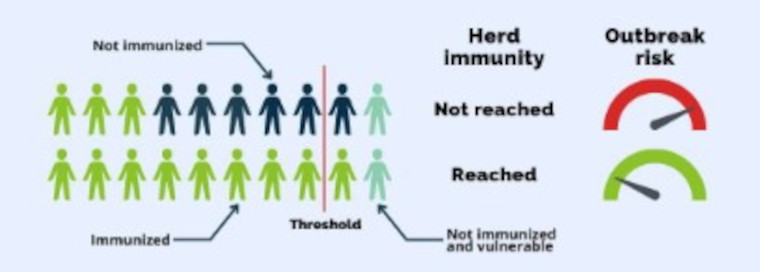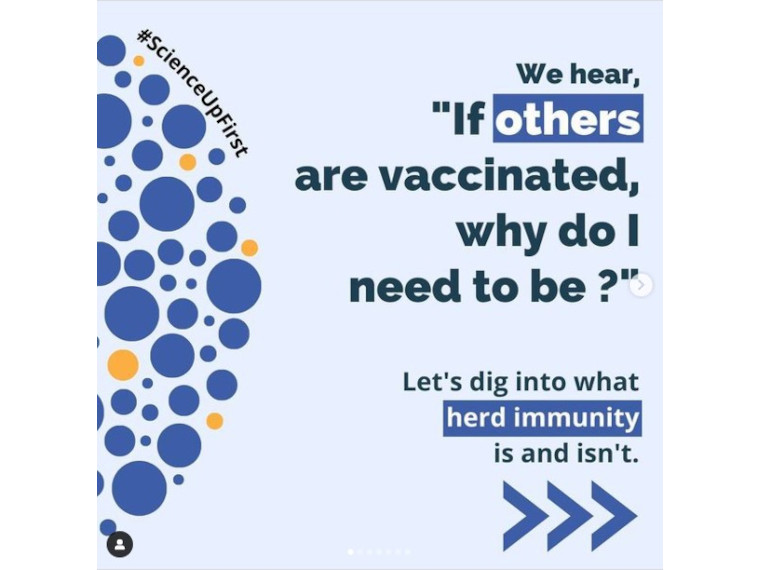Herd immunity, also called community immunity, represents the threshold at which enough individuals in the population are immunized against a certain disease to prevent outbreaks and indirectly protect those who can’t be vaccinated. In theory, this is a simple concept, but it is much more complicated in practice.
Herd immunity depends on how easily transmitted the disease is and how long immunity lasts. For example, measles and stomach flu are both highly contagious and require around 95% of the population to have immunity to prevent outbreaks. However, while measle immunity via vaccine or infection lasts for life, immunity from stomach flu infection only lasts a couple of months. Hence, reaching herd immunity for stomach flu is practically impossible.
Herd immunity is amazing. But there is a problem. If too many people start thinking “well, everyone else is vaccinated, so I don’t need to be,” then achieving community immunity becomes much more difficult.
Even when herd immunity is reached among a population, it does not immunize the unvaccinated. Pockets of unvaccinated individuals can still lead to outbreaks (i.e., the U.S. polio outbreak of 2022).
Herd immunity can theoretically be achieved through natural or vaccine immunity. However, vaccination remains the safest and most direct way to protect yourself, and the most vulnerable, against severe outcomes.
Vaccinated individuals can still pass the pathogen, but the likelihood/risk of transmission is much less probable (i.e. shorter time sick, less severe symptoms, less contact with care workers all of which reduce overall transmission).
Remember…herd immunity only provides indirect protection. As long as the disease exists, transmission is possible. Vaccination offers safer protection against disease. Herd immunity only works if enough people get vaccinated.

This information was made possible by ScienceUpFirst, a national initiative that works with a collective of independent scientists, researchers, health care experts and science communicators.
Sources:
- The health benefits of vaccination | European Union | Posted December 2020
- Herd immunity and COVID-19: What you need to know | Mayo Clinic
- What Is Herd Immunity? | JAMA | Published October 2020
- Vaccine myths and misconceptions | Journal of the American Academy of PAs (JAAPA) | Published August 2014
- Herd Immunity: How does it work? | Oxford Vaccine Group | Posted April 2016
- What Is Herd Immunity? Clarifying Common Misconceptions | Rasmussen University | Posted March 2021
- Debunking the Myth of Non-Vaccine Herd Immunity in COVID-19 | Intermountain Healthcare | Posted November 2020
- Vaccines: Myths and facts | Caring for kids
FR : Les vaccins : les mythes et les faits | Soins de nos enfants
- First U.S. Polio Case in Nearly a Decade Highlights the Importance of Vaccination | Scientific American | Posted August, 2022
- What Is Herd Immunity? (for Parents) | Nemours KidsHealth
- From the Frontlines: Understanding Herd Immunity | American Lung Association | Posted July 2020
- Impact of population mixing between vaccinated and unvaccinated subpopulations on infectious disease dynamics: implications for SARS-CoV-2 transmission | Canadian Medical Association Journal (CMAJ) | Published April 2022
- Transmission and Infectious SARS-CoV-2 Shedding Kinetics in Vaccinated and Unvaccinated Individuals | JAMA | Published May 2022


